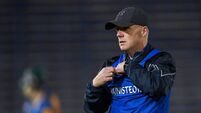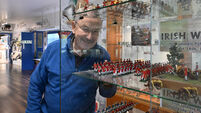A creative lesson in teaching outside the box as students apply for 'jobs'

IF YOU’RE looking for a job, Scoil na mBuachaillí in Clonakilty, Co Cork, has about a dozen going. Only thing is, anyone over the age of 12 need not apply.
To view the job spec, see the back page of the January school newsletter where “situations vacant” include producer, front of house manager, sound crew, lighting crew, and costumes and property manager.
The ad is just one of the many novel approaches to education taken by principal Barth Harrington, for whom thinking outside the box is the name of the game.
The jobs are open to students to apply for in an upcoming school production of Macbeth — the Musical, written by Barth.
Those applying are required to fill out a job application form and enclose a reference from their class teacher. Interviews are held, and those successful are appointed to the posts.
This kind of creativity is endemic in Scoil na mBuachaillí, where a rounded education is top of Barth’s agenda.
When I arrived for a tour of the school last month, I found him sitting in his office, surrounded by paperwork and musical instruments, door open to whoever came his way.
A stack of completed application forms for the aforementioned jobs were on his desk. Curious as to how primary school kids might pitch their suitability, I asked for a quick look.
“I’ve very poor organisational skills,” one child wrote, but “I have excellent communication skills and I’d be good at motivating people and delegating jobs”.
Moreover, he pledged to give his “full commitment to this job”. His honesty, along with his ability at interview stage to clarify how he would handle the “troublesome fellas” paid off, and he got the job.
The way lessons are delivered in the classroom is a far cry from teaching methods back in the day. When I was at school there wasn’t much of a structure in place to support kids who fell behind — a part-time remedial teacher perhaps, but that was as good as it got. In Scoil na mBuachaillí, there are several programmes designed to improve literacy and numeracy, and not just for students in need of extra help.
Órla O’Keeffe is the teacher with responsibility for the school’s Reading Recovery programme.
It’s targeted at the lowest literacy achievers after their first year of school. The programme involves intensive one-to-one lessons for 30 minutes a day.
The lessons are tailored to each child and the goal is to make them effective readers and writers, able to work within the average band of their class at age-appropriate levels of literacy.
It’s been operating within the school for the past nine years and, according to Órla, is “95%-96% successful”.
The school’s Literacy Lift- Off programme is a “spin-off” of the Reading Recovery scheme, Órla says.
It’s delivered by teacher Carol O’Boyle. I witness its operation in the classroom.
At various tables, or “stations”, children are engaged in different activities designed to improve literacy, spending eight minutes at each station.
Depending on which station the child is sitting at, they could be rereading a familiar book, reading a new book, working on phonetics using magnetic letters — trying to spell out words through sound — or writing sentences using words they’ve learned.
“The programme has had positive results throughout the school,” Carol says, helping nurture a love of reading, with kids regularly requesting the next book in a series that they’ve read in school.
It’s delivered every day from senior infants up to third and fourth class, and to the older classes three days a week. Parents are encouraged to help out and volunteers, such as those who want to be teachers and are looking for classroom experience, also assist.
Carol also looks after the Maths Recovery programme, which has a similar structure to the reading programme and which is aimed at first-class pupils.
“We identify the boys who are falling behind in their classwork and they are taken out of class for 20 minutes a day for extra help,” she says.
In the junior infants class I also witness in action the Aistear programme, which is essentially learning through play.
Again, the activity takes place at different stations, and the day’s theme is Jack and the Beanstalk.
At one table, children are involved in arts and crafts, using crepe paper to make beanstalks and hone their fine motor skills; at another they’re getting to know the sequence of the story.
At a third station they’re engaged in acting out the story, helping the development of oral language skills, and at another table they’re practising counting, based on various props in the story.
“The idea is to integrate as many subjects as you can through one story in one Power Hour,” says teacher Mary Horgan.
Across the corridor, third class are putting on a puppet show. This is thanks to Jillian Barrett, who was doing puppetry in the local art centre and emailed the school to see if she could put her talents to further use.
They were happy to let her. The extremely professional production I enjoy is Little Red Riding Hood.
A mic’d-up nine-year-old tells us to “sit back, relax, and enjoy the show” and everyone very obviously does.
The puppeteer has taught them not just how to stage a proper puppet show, but also how to make their own marionettes and how to stage a shadow show.
Throughout my visit, I am show around by pupils Chris Kenneally and Eoin Downey, both obvious contenders as the school’s ‘Gentleman of the Week’.
They bring me to the music room, where I am treated to a very respectable rendition of Neil Young’s ‘Keep on Rockin’ in the Free World’ in a room decorated with pictures of legends such as Thin Lizzy, Rory Gallagher, and Ray Davies. Not a Harry Styles in sight.
One youngster is sitting on what looks like a speaker, but turns out to be a cajón, a box-shaped percussion instrument originally from Peru, played by slapping the front or rear with the hands. The boys first encountered a cajón when making their charity Christmas single, ‘Butterfly Child’, which they sang for Dáithí and Maura on RTÉ daytime TV.
The song, a musical collaboration between Scoil na mBuachaillí and children from the Samburu tribe in Kenya, was written by Barth after he was approached by representatives of The Thorn Tree Project, an international educational initiative based in Kenya.
The song, which aims to raise funds for the project, as well as for Scoil na mBuachaillí, was performed to the accompaniment of 15 cajóns, fuelling a huge Christmas demand in Clonakilty for the drums.
“The lads loved them; 37 fellas got cajóns for Christmas,” Barth says.
For those not interested in singing, dancing, or acting, there’s chess — with 70 of the 262 boys in the school taking part, among them Cork schools champion Dylan O’Donovan (sixth class) .
And there’s orienteering — Tim McCarthy, sixth class, is the All-Ireland orienteering champion. There’s also swimming, soccer, GAA, rugby, computing, film-making, and the Quizzard quiz tournament. There’s even a kiln for the creatives — when I visit, pottery hearts are cooling in preparation for Valentine’s Day — and a cookery room where first class is filing out amid mounds of cooling buns.
Over in the school hall, there are several exhibits on display for enrolment day, to give parents a flavour of school activities.
Two lads are sitting in a kayak — pupils go kayaking off Reen Pier in Union Hall and Lough Ine near Baltimore.
Sixth class students save during the year for a chance to wind-surf for a couple of days off Inchydoney Beach.
Another exhibit includes a model farm. Cillian McDonald and Aaron Daly, both sixth-class pupils, built the sheds, stone walls, machinery, and silage pit.
Two other students pose with a giant robot, for which they won a plaque of excellence from Science Foundation Ireland as part of its Discover Primary Science programme.
Another couple of students demonstrate bouncing raisins and how to make a papier-mache volcano erupt using bread soda.
By the end of my trip, I’m sold on the story of Scoil na mBuachaillí.
On the way out, I notice a bug hotel, a layered wooden hutch designed by the school caretaker to attract bugs.
It’s the kind of thing young fellas love. I get the sense that this is a school that really ‘gets’ boys.
Back in the day when Micheál Martin was minister for education, he said that Scoil na mBuachaillí “should be used as a model for other schools around the country”.
That’s an endorsement worth hanging on to, given the odds on who becomes our next taoiseach.














